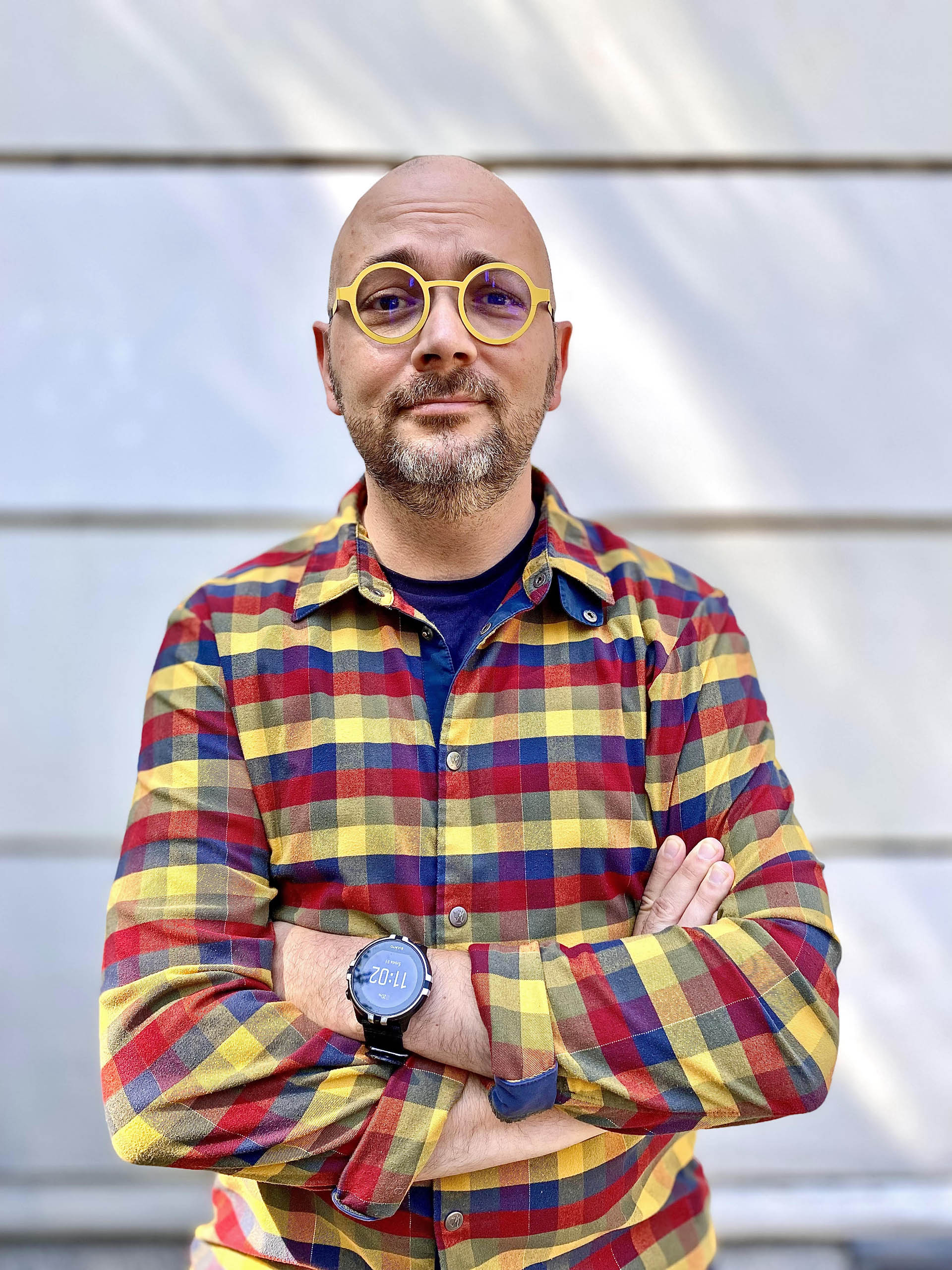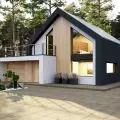The climate crisis is a fact. And the fact that architecture has a not inconsiderable share in it, too (although this tends not to be talked about loudly). At the same time, we can't give up building, and architects are needed today more than ever. Filip Springer, author of the book "Gray Hour. Time for a New Architecture", talks about the challenges of modern times, questions without obvious answers, and reflection, without which we will not be able to fix the world.

Filip SPRINGER - writer and photographer. For his debut "Miedzianka. A Story of Disappearance" (2011), he was nominated for the Nike Literary Award, the Ryszard Kapuściński Award, the Gdynia Literary Award and the Angelus Central European Literary Award. He has received scholarships from the National Cultural Center and the Ryszard Kapuściński "Herodot" Foundation. His books are translated into English, German, Russian and Hungarian. Program director of the Institute of Reportage in Warsaw, co-founder of the School of Ecopoetics (together with Prof. Julia Fiedorczuk), originator and co-creator of the literary Festival on the Road. Curator of the photographic project Migawki. Photographic Archive of Revitalization.
Błażej Ciarkowski: Are you an idealist?
Filip Springer: No, probably not. Why do you ask?
Błażej Ciarkowski: Reaching for "Gray Hour", I expected definitely more depressing content. And here's a surprise: against the backdrop of more and more catastrophic predictions, you seem to be saying that all is not yet lost.
Filip Springer: I think we're at a point in history when we have a choice between two attitudes: either we acknowledge that the world can be better, or we have to admit that it's a done deal. And I very much don't want to think that it's a done deal. Besides, in light of what science says, I believe we still have something to do. I believe that man can afford a little more than what he has organized for himself at the moment. If this is idealism, it means we are in a very grim situation.
Błażej Ciarkowski: And in this situation, pessimism seems to be the more natural attitude.
Filip Springer: While it was relatively easy to write a book that is one big complaint about Polish public space, i.e. "Bathtub with a colonnade", it seems to me that this is not the right time to write such a book about climate change and architecture. However, this is a problem of a different caliber.
Błażej Ciarkowski: Since you mentioned "Bathtub with a colonnade", I would like to refer to another book of yours that made a huge impression on me, namely "Mein Gott, how beautiful". It seems to me that it is more personal than "The Gray Hour," and at the same time it talks about basically the same thing.
Filip Springer: And I think it is a bit like that. If I had to point to the most personal one on my list of books, I would probably choose "Mein Gott". There are connections between the two books, although not obvious. Both of them were written when I began to deal seriously with climate change issues. I treat environmental crises in the broadest sense as a context for my writing, rather than as a topic in itself. One could also say that "The Gray Hour" is a book for others, while "Mein Gott" is perhaps a book just for me....
"Gray Hour. Time for new architecture"
© Karakter Publishing House
Błażej Ciarkowski: So who are these others? As I was reading, I wondered if it's not that you convince the convinced. Will Przemo Łukasik, even if he reads your book, take its message to heart? To put it bluntly - did you write thinking about architects?
Filip Springer: Yes, I wrote with architects in mind, who are mentioned there by name. Of course, I don't believe in such causality of this book that they will read it and hit their breasts. I assume that those who are interested in architecture will notice "The Gray Hour". And that's why I mention certain people by name, which is impolite, because as a rule you don't do that, you just write "a recognized architect at a certain event". And I write "Przemo Łukasik at the Łódź Design Festival". I do this because architects who attract a lot of people to the audience (and Przemo Łukasik is such a person, and so is Ewa Kuryłowicz), who have reach, budgets, authority, have everything to start setting new directions in architecture, experimenting, exploring, and having creative fun at the same time. But they don't do that.
I'm not trying to say in this book that we don't need architects anymore. On the contrary, we need them even more now. Who, if not the studios and those people who already have money, positions, status and authority, should invent new architecture? After all, not those who have just graduated from college and are barely making ends meet, or who are workhorses in large studios. And in this sense, I hope that people who study architecture, having read this book, will begin to expect the great, the famous and the established to behave a little more decently.
So far, decency has been mostly about form. Each of the studios I've mentioned designs visually very decent buildings that are simply worth looking at and you want to stay with them. But the days when that was enough are over. Now something more is needed.
Błażej Ciarkowski: For people twenty years younger than us, for architecture students, visual decency may not be enough.
Filip Springer: Some are probably still influenced by the charm of architects who build icons. But I'm convinced that the young are more serious about making predictions about what will happen in twenty years. They will be forty years old then, as old as we are now. And I think this prospect does not fill them with joy.
Błażej Ciarkowski: You mention the Lacaton & Vassal studio, which presents a new look at architecture. A look that is up to the challenges designers face today. One more name came to my mind - Shigeru Ban. Is this, in your opinion, any answer to these challenges? Because on the one hand he designed the Pompidou Center in Metz, and on the other - paper architecture in places where people have experienced the negative effects of climate change. And on the other hand, Ban flies around the world by airplane, leaving behind not only paper houses, but also a massive carbon footprint.
Filip Springer: We have several different threads here, and it would be good not to mix them. I can't say that I see an answer to all modern challenges in the attitude that Lacaton and Vassal present. I do, however, see a desire to set a direction. What I expect is an honest search for answers. Of course, we can wonder how sincere it is to seek these answers by designing paper architecture in disaster areas when one flies to these places by plane. However, the very fact that the authority of this particular architect is being used for such unusual solutions and showing that one is searching is of great value to me.
I would very much hate to step into the role of a moralizer and point out that someone flew by plane and someone else came by car. Although it hits me every time I'm at the Łódź Design Festival and see that everyone comes to Łódź by car. What I expect, and what "Gray Hour" is supposed to be about, is using authority and professional position to consciously and sincerely seek new solutions.
Architects have always made a name for themselves as people eager to take on new challenges (tight plot, small budget, intensive program, and still need to be made to fit in with what's next door). It seems to me that adding another piece to this difficult puzzle, in the form of the environment, makes the fun even more interesting.
Błażej Ciarkowski: Perhaps it is a matter of limited knowledge? A gap in architectural education, whose curriculum has not kept up with contemporary issues?
Filip Springer: Sometimes when I talk to the most recognized Polish architects, I get the impression that they haven't read what they should read. At least in the last decade.
Błażej Ciarkowski: You once said that architecture and its harm to the environment is the elephant in the room: we feel its presence, but we don't talk about it. Meanwhile, an article in The Guardian describing concrete as the world's most harmful material appeared almost six years ago. Why aren't we talking about the harmfulness of construction?
Filip Springer: Because it's very complicated. If we talk about airplanes, you can say "don't fly to Lisbon for a long weekend". This is a simple message. Sometimes, when I say "let's build fewer buildings", without even pointing out which ones (although I can imagine that if we sat down in a larger group, we would be able to negotiate which buildings are unnecessary), that message alone creates fury. My impression is that the huge ecological footprint that architecture leaves behind is virtually invisible, hidden behind the fence of the construction site. And then a new, glowing, cool-to-use building appears. And you don't have to think about it anymore. And if you stick all sorts of certificates to it, you already have a cleared conscience at all.
Błażej Ciarkowski: So you don't believe in sustainable architecture? Wojciech Januszczyk says outright that such a thing does not exist.
Filip Springer: I don't believe it. When I hear the word "sustainable", I automatically become more suspicious. The cursed word "development" is very often tacked on to this "sustainability", and using these two terms side by side is a logical error. In this sense, I agree with Wojtek.
Błażej Ciarkowski: So are you saying "no" to green roofs, green facades? Are you saying "no" to projects like Bosco Verticale in Milan [proj.: Boeri Studio - editor's note]?
Filip Springer: I was at Bosco Verticale with a bunch of photographers, and we were shown the building in terms of a miracle. But we all felt deeply disgusted. Of course it's fun to look at, but when you think about what it is and why it's there, and where it's there, and who's going to live there, the whole investment raises internal resistance.
It's not that I don't believe in green roofs and green facades. I prefer the roofs to be green rather than black. And I like the facade to be green. Just so it doesn't entail additional environmental costs. It can be done.
Błażej Ciarkowski: Since we are at Bosco Verticale, which is somewhat of a hybrid of a house with a garden and trees outside the window and a skyscraper in the inner city, let's talk about the densification you advocate in the pages of "Gray Hour". This is interesting because most cities in Poland are depopulating. Most of the time, they are moving to neighboring municipalities. And you would like to deny people the right to realize the dream of a house with a garden?
Filip Springer: Yes, preferably by decree. I'm serious about this. I think this is one of those things that will probably never happen, especially in Poland. But I completely agree with those who say that building single-family houses should be gradually banned.
I'm very fond of the topic of densification, because it arouses strong emotions in people - fears that they will live like in Bliska Wola. Meanwhile, let's look at the five most densely built-up square kilometers in Poland. They are Muranów, Nowolipki, Olbin, downtown Szczecin and Miasteczko Wilanów. None of these locations seems like a terrible place to live. So behind the demand for a dense city is not a city of skyscrapers, but a city of intensive multifamily housing, provided with greenery and normal streets.
Błażej Ciarkowski: I must admit that I was surprised by the presence of Muranów on this list. There, the intensity of development seems to be lower than in most contemporary developer "neighborhoods"...
Filip Springer: Rarely does a developer have a kilometer-by-kilometer square to work with.
Błażej Ciarkowski: What if he had?
Filip Springer: The larger the plot of land a developer has, the more he can afford. The history of Żerań is a bit about that. Maybe something pretty decent can be done there...
Błażej Ciarkowski: I hope this will be living proof that things can be done differently. Let's go back to those big names. I wanted to ask you about the so-called OMA Manifesto saying that the future belongs to conservation understood as adaptation of what is already there. Because we have enough buildings. You'll admit that in the case of Rem Koolhaas it trumpets....
Filip Springer: ...profound hypocrisy.
Błażej Ciarkowski: And what would you say about the inverted motto of Bjarke Ingels, who says "YES is more". I would say that the future is "NO is more".
Filip Springer: I suppose Bjarke Ingels would disagree with that. But then again, look at Koolhaas, Reinier de Graaf or Maciej Miłobędzki, who writes very interesting stuff while co-founding one of the biggest studios in Poland. I agree that this is a kind of hypocrisy. But the value for me is the very fact that he articulates his doubts. Reinier de Graaf writes that the louder architects talk about their causality and responsibility, the more they are in fact subordinated to capital. I assume he also writes this on his own behalf. Even when I hear Robert Konieczny demanding a breakthrough in architecture on the occasion of the recent investment in Poznań [Aura - note BC], which I consider an example of greenwashing, I appreciate the gesture. I would have preferred if he had said it on the occasion of PLATO in Ostrava, which is a pretty good example of adaptation of existing substance.
I would expect much more from the creators of this format, but I still appreciate their words. It's better than staying silent, burying your head in the sand or claiming that if I don't design something, someone else will do it worse.
Błażej Ciarkowski: Thank you for the interview.
Błażej Ciarkowski
Photo: © Karakter Publishing House
more: A&B 11/2024 - Soul of Europe, Soul of the City,
download free e-issues of A&B

















